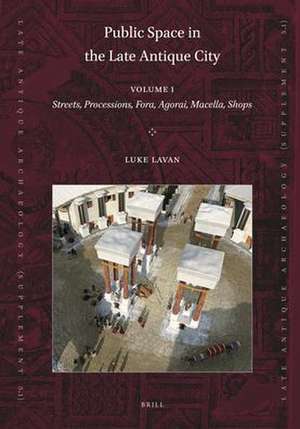Public Space in the Late Antique City (2 vols.): PART 1: Streets, Processions, Fora, Agorai, Macella, Shops. PART 2: Sites, Buildings, Dates: Late Antique Archaeology (Supplementary Series), cartea 5
Autor Luke Lavanen Limba Engleză Hardback – 17 mar 2021
Preț: 2064.07 lei
Preț vechi: 2517.15 lei
-18% Nou
Puncte Express: 3096
Preț estimativ în valută:
394.97€ • 413.21$ • 328.09£
394.97€ • 413.21$ • 328.09£
Carte indisponibilă temporar
Doresc să fiu notificat când acest titlu va fi disponibil:
Se trimite...
Preluare comenzi: 021 569.72.76
Specificații
ISBN-13: 9789004413726
ISBN-10: 9004413723
Dimensiuni: 210 x 297 mm
Greutate: 5.38 kg
Editura: Brill
Colecția Brill
Seria Late Antique Archaeology (Supplementary Series)
ISBN-10: 9004413723
Dimensiuni: 210 x 297 mm
Greutate: 5.38 kg
Editura: Brill
Colecția Brill
Seria Late Antique Archaeology (Supplementary Series)
Notă biografică
Luke Lavan is Lecturer in Archaeology at the University of Kent, Canterbury, where he co-ordinates the Centre for Late Antique Archaeology. His doctorate (2001) considered Provincial Capitals in Late Antiquity. He is series editor of Late Antique Archaeology. He was a post-doctoral research fellow of the Sagalassos Archaeological Project 2005-2007 and directed the Kent section of the Kent-Berlin Late Antique Ostia Project 2008-2012.
Recenzii
'Luke Lavan’s Public Space in the Late Antique City represents a magnificent summation to almost twenty years of research, encompassing fieldwork – survey and excavation, innumerable city visits to check the evidence on the ground, and exhaustive library research. The catalogue listing the urban amenities of the Late Antique City is in itself an extraordinary resource for all future studies of the Roman urban fabric. Here we finally have the data, literally from the ground up, to evaluate the competing theories on the decline, continuity or flourishing of public life in the towns of the final centuries of Roman imperial power.' - John Bintliff, Professor Emeritus, University of Edinburgh and Leiden
‘Luke Lavan’s Public Space in the Late Antique City is a pathbreaking achievement as a synthesis, which makes much previous work on the subject unnecessary to read. It is firmly based in a uniquely detailed account of how the monumental life of late Roman cities worked in material terms, grounded in a remarkable knowledge of the archaeology, as set out in an invaluable volume of appendices, which every late antique scholar will also need to have by them. In many ways, this book is a new starting-point for late antique archaeology and material culture. I wish I had had it by me when I wrote on this topic, more superficially, twenty years ago.’ - Chris Wickham, Chichele Professor of Medieval History emeritus, University of Oxford
‘Ce livre offre un aperçu très complet de l’organisation de l’espace public des villes de l’Antiquité Tardive (rues, fora/agorai, macella, boutiques). Les villes, à l’intérieur de frontières gardées par des castra, sont riches et peuplées, attachées à leur passé. L’église s’introduit dans cet espace sans le remettre en cause. Les villes gardent leur decorum antique, leur équipement civique, leurs bouleutèria, leurs thermes, leurs lieux de spectacle (théâtres, hippodromes). Constantinople s’attache à reproduire les caractéristiques de Rome pour se poser en capitale politique et religieuse. Les évêques vers la fin du Ve s. s’imposent peu à peu en leaders de leur ville, y compris de son administration, jouant de leur poids religieux pour adoucir une hiérarchisation sociale forte héritée de l’Antiquité.’ - Jean-Pierre Sodini, Professeur émerité, Université Paris I Panthéon-Sorbonne, Membre de l'Académie des Inscriptions et Belles-Lettres
‘Luke Lavan’s Public Space in the Late Antique City is a pathbreaking achievement as a synthesis, which makes much previous work on the subject unnecessary to read. It is firmly based in a uniquely detailed account of how the monumental life of late Roman cities worked in material terms, grounded in a remarkable knowledge of the archaeology, as set out in an invaluable volume of appendices, which every late antique scholar will also need to have by them. In many ways, this book is a new starting-point for late antique archaeology and material culture. I wish I had had it by me when I wrote on this topic, more superficially, twenty years ago.’ - Chris Wickham, Chichele Professor of Medieval History emeritus, University of Oxford
‘Ce livre offre un aperçu très complet de l’organisation de l’espace public des villes de l’Antiquité Tardive (rues, fora/agorai, macella, boutiques). Les villes, à l’intérieur de frontières gardées par des castra, sont riches et peuplées, attachées à leur passé. L’église s’introduit dans cet espace sans le remettre en cause. Les villes gardent leur decorum antique, leur équipement civique, leurs bouleutèria, leurs thermes, leurs lieux de spectacle (théâtres, hippodromes). Constantinople s’attache à reproduire les caractéristiques de Rome pour se poser en capitale politique et religieuse. Les évêques vers la fin du Ve s. s’imposent peu à peu en leaders de leur ville, y compris de son administration, jouant de leur poids religieux pour adoucir une hiérarchisation sociale forte héritée de l’Antiquité.’ - Jean-Pierre Sodini, Professeur émerité, Université Paris I Panthéon-Sorbonne, Membre de l'Académie des Inscriptions et Belles-Lettres






